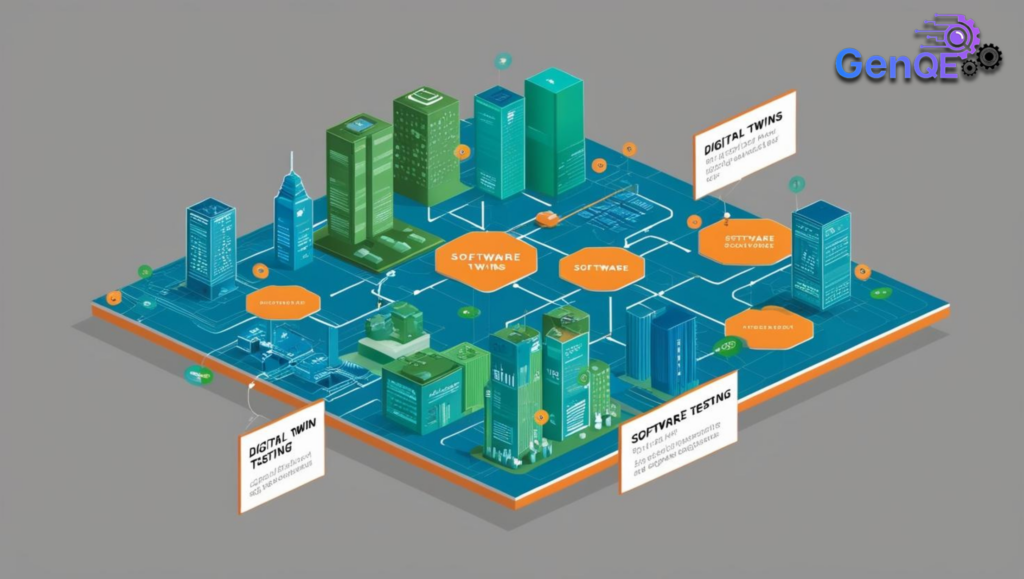
Introduction
Software testing is at the core of delivering high-quality, reliable, and secure software solutions. With the increasing complexity of applications, traditional testing methodologies face limitations in replicating real-world conditions accurately. The introduction of Digital Twins has revolutionized the way software is tested, providing a real-time, predictive, and adaptive approach to quality assurance.
A Digital Twin is a virtual representation of a real-world system, application, or infrastructure, continuously synchronized with real-time data. It enables realistic testing, predictive maintenance, risk assessment, and performance optimization in a controlled environment.
This article provides an in-depth exploration of Digital Twins in software testing, covering:
✅ Evolution of Software Testing Approaches
✅ Traditional vs. Digital Twin-Based Testing
✅ Technical Components of Digital Twins
✅ Key Applications in Software Testing
✅ Case Studies from Industry Leaders
✅ Challenges and Limitations
✅ Future of Digital Twins in Software Testing
Let’s begin by understanding why software testing needs Digital Twins.
1. The Evolution of Software Testing
Software testing has evolved over decades to accommodate changing technologies, architectures, and user expectations.
1.1 The Early Days of Software Testing
In the 1960s and 1970s, software testing was largely manual and focused on functional validation using predefined test cases. Testing was conducted in isolation, often as an afterthought in the software development lifecycle (SDLC).
1.2 Automated Testing Revolution
The 1990s and early 2000s saw the rise of automated testing frameworks, such as:
- Selenium for web testing
- JUnit for unit testing
- LoadRunner for performance testing
Automation improved testing efficiency but still lacked real-time adaptability.
1.3 The Rise of AI and Digital Twins
With the emergence of AI, ML, and IoT, the need for realistic and continuous testing became more critical. Digital Twins provide a dynamic, real-time, and predictive approach to testing, overcoming the limitations of static test environments.
2. Understanding Digital Twins in Software Testing
A Digital Twin is a virtual replica of a software system, infrastructure, or business process that simulates real-world conditions with high accuracy.
Unlike traditional test environments, which rely on predefined test cases and simulated inputs, a Digital Twin is continuously updated with live data, making it highly adaptable and predictive.
2.1 Characteristics of Digital Twins in Software Testing
✔ Real-Time Data Synchronization – Digital Twins update dynamically, providing real-world accuracy.
✔ Predictive Analysis – AI-driven analytics help identify potential failures before they happen.
✔ Comprehensive Test Coverage – Covers edge cases and complex scenarios often missed in traditional testing.
✔ Automation and Self-Healing – Can detect, diagnose, and even fix issues automatically.
2.2 Components of Digital Twins in Testing
A Digital Twin-based testing framework consists of:
- Virtual Environment: A simulated software replica.
- AI & Machine Learning Models: Predictive algorithms for test automation.
- Real-Time Data Integration: Live feeds from production systems.
- Cloud Infrastructure: Scalable computing power.
- Security & Compliance Layers: Ensuring regulatory adherence.
Let’s now compare Digital Twin-based testing with traditional testing approaches.
3. Traditional vs. Digital Twin-Based Testing
3.1 Challenges of Traditional Software Testing
Traditional testing methods rely on predefined scenarios and simulated test environments, which often fail to capture real-world complexities. Some key limitations include:
- Static Test Cases: Limited adaptability to real-time system changes.
- Delayed Defect Detection: Many issues are identified post-deployment, increasing costs.
- High Testing Costs: Requires physical test environments and large test teams.
- Lack of Predictive Insights: No way to foresee potential failures before they occur.
3.2 Advantages of Digital Twin-Based Testing
✅ Real-World Simulation: Digital Twins continuously mirror live systems, providing highly realistic test environments.
✅ Continuous Testing: Testing can occur 24/7 with real-time monitoring.
✅ Cost Reduction: Eliminates the need for physical infrastructure.
✅ AI-Driven Predictive Testing: AI models anticipate failures before they impact users.
✅ Improved Security Testing: Simulates cyberattacks and vulnerabilities in a safe, controlled environment.
4. Key Applications of Digital Twins in Software Testing
Digital Twins have transformed multiple domains of software testing, including:
4.1 Performance Testing
Digital Twins simulate different conditions such as:
- High Traffic Loads 🚀
- Server Failures 🔥
- Network Latency 🌐
This helps identify bottlenecks and scalability issues.
4.2 Security Testing
By replicating cyberattacks, Digital Twins improve penetration testing and vulnerability detection.
4.3 Regression Testing
Continuous testing ensures that new updates do not introduce new bugs.
4.4 User Experience (UX) Testing
Digital Twins replicate user interactions in real time, helping improve:
✔ Responsiveness
✔ Accessibility
✔ Cross-platform Compatibility
4.5 IoT and Embedded Systems Testing
IoT applications benefit significantly from Digital Twins, enabling sensor data simulation and network behavior analysis.
5. Case Studies: Digital Twins in Action
5.1 Tesla’s Autonomous Driving System
🚗 Tesla uses Digital Twins to simulate millions of real-world driving conditions, allowing their self-driving AI to learn and adapt without real-world testing risks.
5.2 Healthcare & Medical Device Testing
🏥 Hospitals use Digital Twins to test medical software for real-world patient scenarios, reducing risks in life-critical applications.
5.3 Cybersecurity and Banking
🏦 Financial institutions use Digital Twins to simulate cyberattacks, identifying vulnerabilities before hackers do.
6. Future of Digital Twins in Software Testing
The future of Digital Twins in software testing includes:
🚀 AI-Powered Self-Healing Software – Digital Twins will detect, diagnose, and fix bugs autonomously.
🔗 Integration with Blockchain – Secure data transactions will enhance Digital Twin security.
⚡ Real-Time Predictive Analytics – AI-driven insights will improve test efficiency and software reliability.
Conclusion
The adoption of Digital Twins in software testing is driving a new era of quality assurance, improving efficiency, accuracy, and cost-effectiveness. Organizations that leverage Digital Twins will gain a competitive edge in delivering highly reliable and scalable software solutions.
🚀 The future of software testing is not just automated—it’s virtual, intelligent, and powered by Digital Twins!